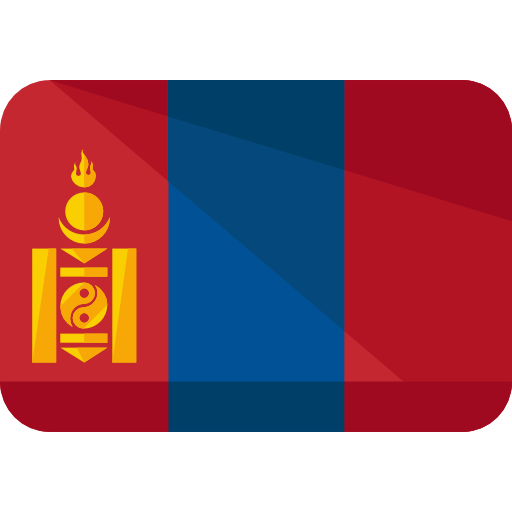When spring comes, waterfowls start to migrate to the Mongolian lake and rivers during night time. At the end of the March, I headed to backwater located in Songino where many birds have already arrived. Duck flock flew off at first when people went closer to the back.
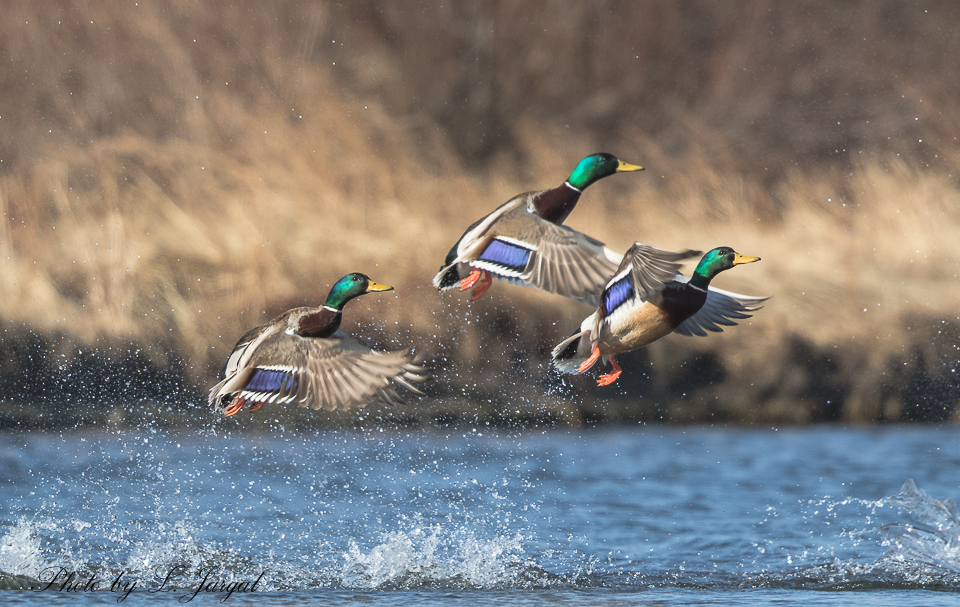
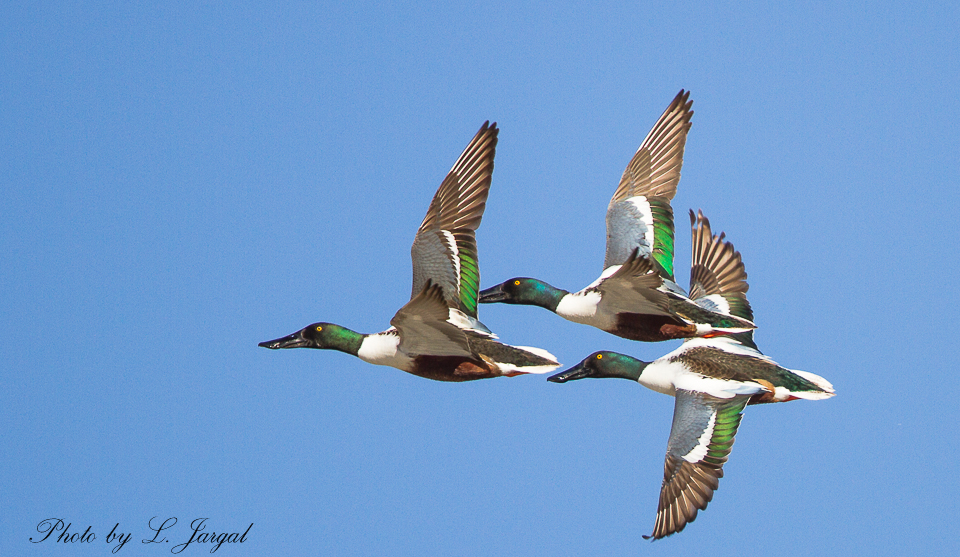
The Anatidae in Mongolia includes ducks, geese, swans and other species of birds. Ducks have smaller bodies, short legs, necks and have mild, not as sharp, beak. Those species of birds are fully capable of swimming and fast at fly-off and land. Male ducks have beautiful feather in spring.
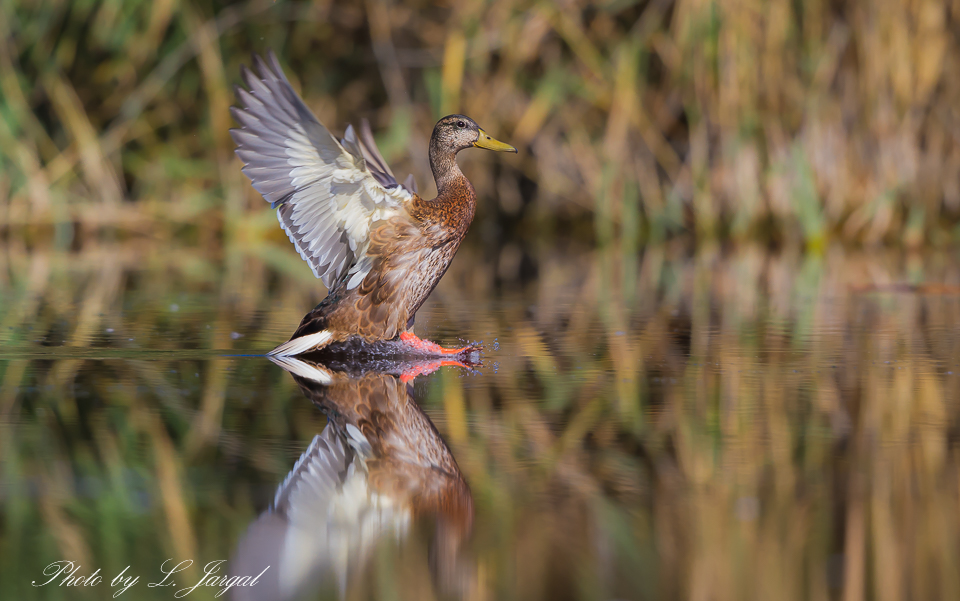
The female mallard or wild duck (Anas platyrhynchos) is predominantly mottled with each individual feather showing sharp contrast from buff to very dark brown, a coloration shared by most female dabbling ducks, and has buff cheeks, eyebrow, throat and neck with a darker crown and eye-stripe.
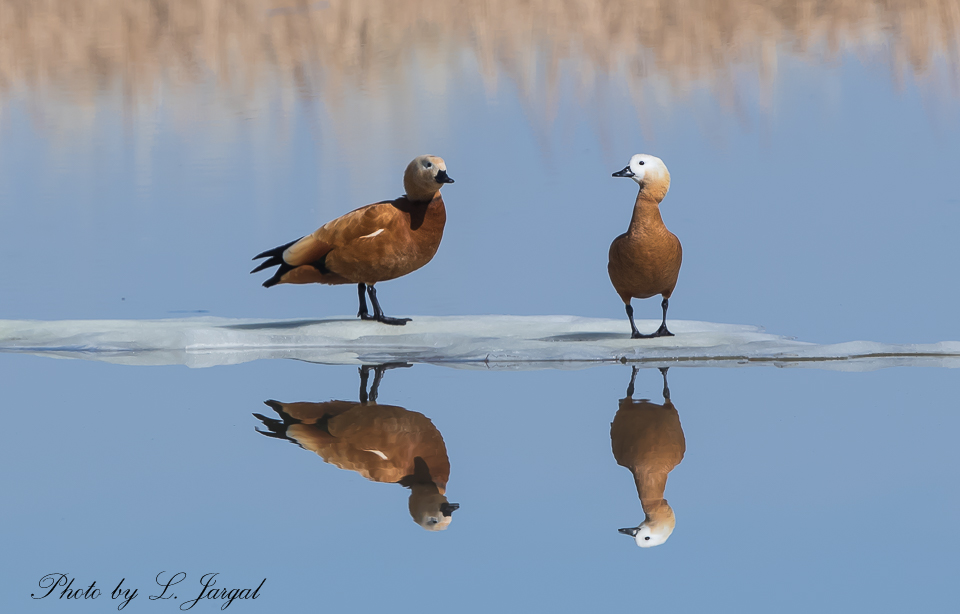
There would not be a Mongolian who is not familiar with the ruddy shelduck (Tadorna ferruginea). It has orange-brown body plumage and a paler head. The wings are white with black flight feathers. The ruddy shelduck is usually found in pairs or small groups and rarely forms large flocks. However, moulting and wintering gatherings on chosen lakes or slow rivers can be very large.
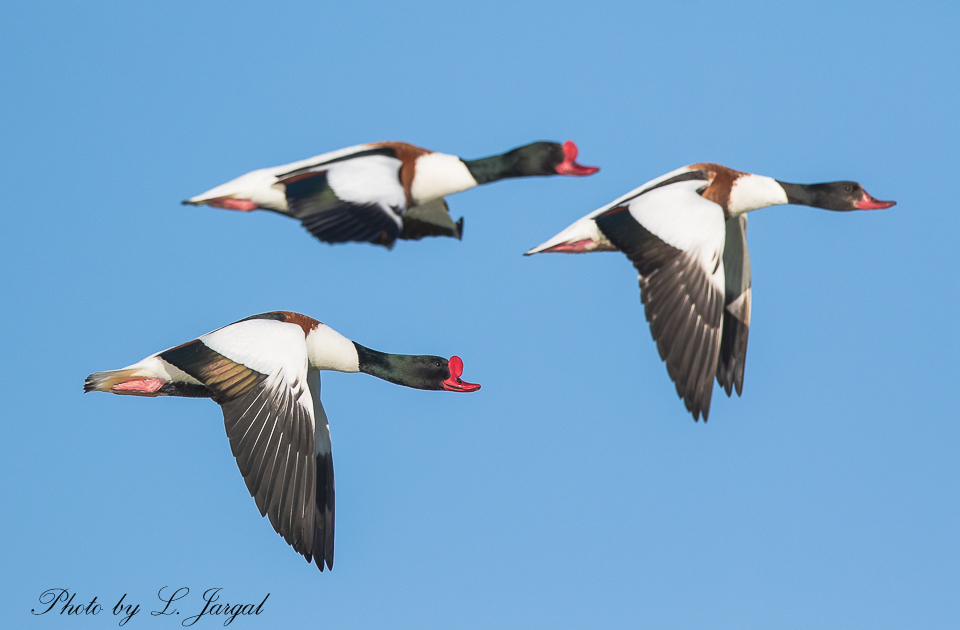
Another beautiful birds summering in Mongolian lake and river is the common shelduck (Tadorna tadorna). Sexes are similar, but the female is smaller, with some white facial markings, while the male is particularly crisply coloured in the breeding season, his bill bright red and bearing a prominent knob at the forehead.

The common goldeneye (Bucephala clangula) is named for its golden-yellow eye. Adult males have a dark head with a greenish gloss and a circular white patch below the eye, a dark back and a white neck and belly. Adult females have a brown head and a mostly grey body. Their legs and feet are orange-yellow. They usually found in rivers and lakes nearby forest. Naturally, they nest in cavities in large trees.
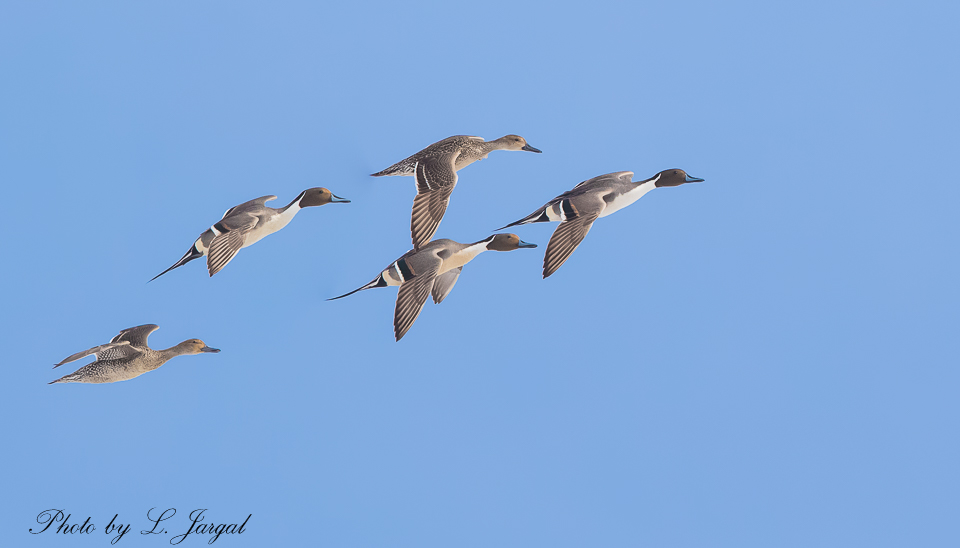
The pintail or northern pintail (Anas acuta) is the most common species of duck. They seem very beautiful when they fly due to they have narrow necks and tail.
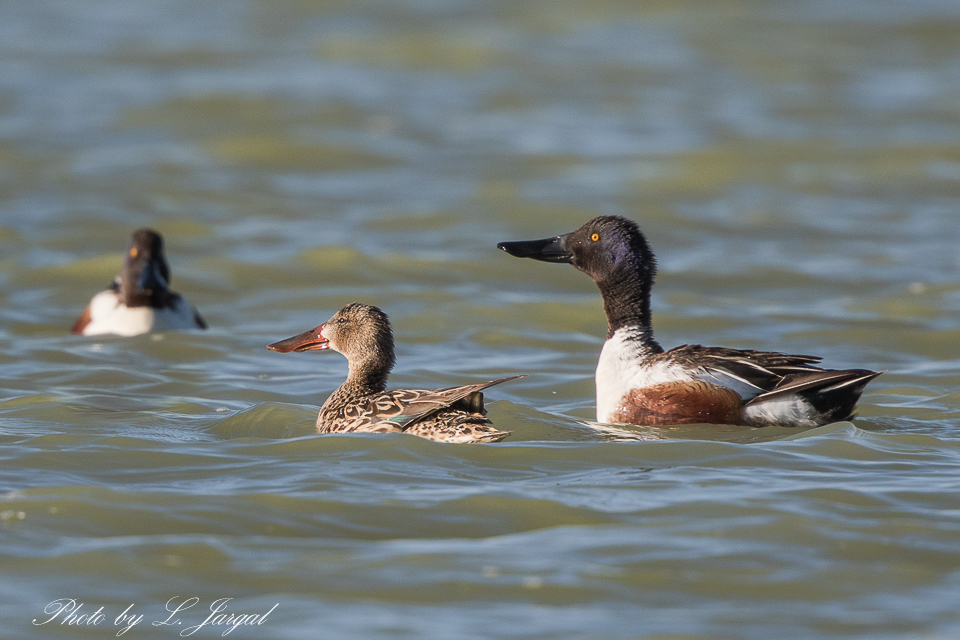
The northern shoveler has an iridescent dark green head, white breast and chestnut belly and flanks. Northern shovelers feed by dabbling for plant food, often by swinging its bill from side to side and using the bill to strain food from the water. They use their highly specialized bill (from which their name is derived) to forage for aquatic invertebrates – a carnivorous diet. Their wide-flat bill is equipped with well-developed lamellae – small, comb-like structures on the edge of the bill that act like sieves, allowing the birds to skim crustaceans and plankton from the water's surface.
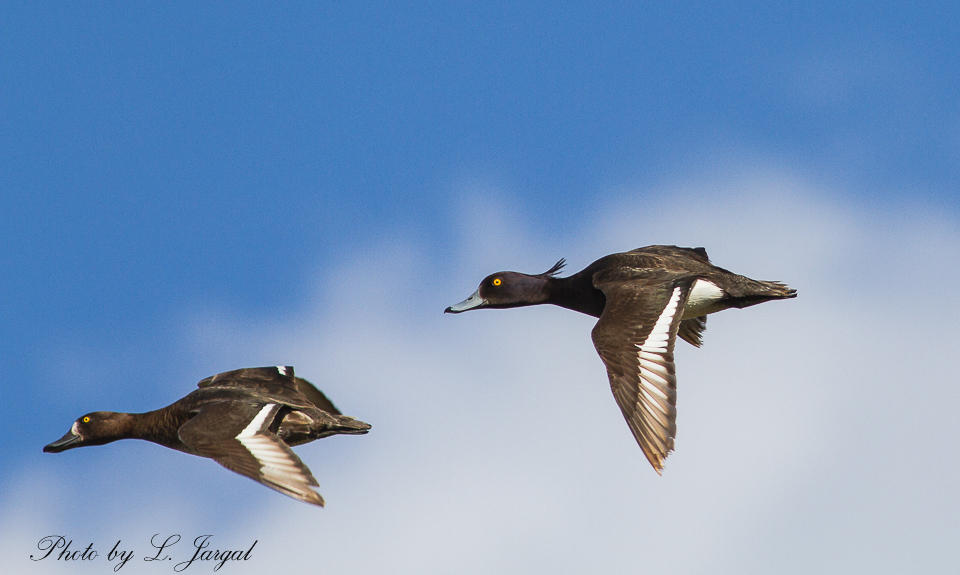
The Tufted duck (Aythya fuligula) has an obvious head tuft that gives the species its name. These birds feed mainly by diving, but they will sometimes upend from the surface. It is believed to have expanded its traditional range with the increased availability of open water due to gravel extraction, and the spread of freshwater mussel, a favourite food.

The red-crested pochard (Netta rufina) has a rounded orange head, red bill and black breast. The flanks are white, the back brown, and the tail black. The female is mainly a pale brown, with a darker back and crown and a whitish face. Eclipse males are like females but with red bills. They feed mainly by diving or dabbling. They eat aquatic plants, and typically upend for food more than most diving ducks.
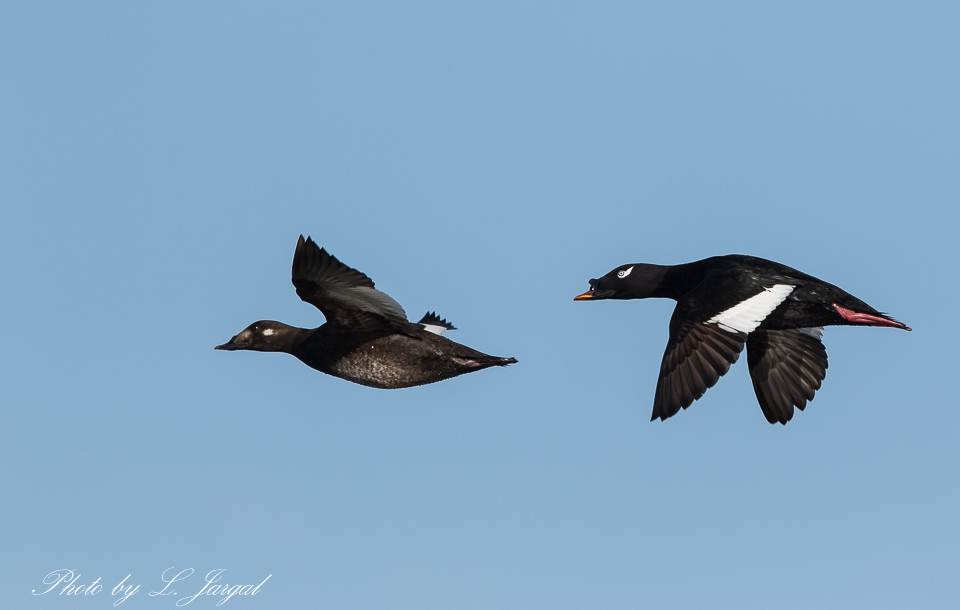
I was lucky to have chance to observe the white-winged scoter (Melanitta deglandi or Melanitta fusca deglandi) at back as it mostly breed in larger lakes. It is characterised by its bulky shape and large bill. This is the largest species of scoter. Female is brown with pale head patches. Males are all black, except for white around the eye and a white speculum. When you are traveling to the countryside during the summer, stop at the rivers and lakes and observe waterflows.
PS: If you want to travel L.Jargalsaikhan`s wonderful world of birds, click here please.
If you want to visit L.Jargalsaikhan`s flickr profile, click here please.
When spring comes, waterfowls start to migrate to the Mongolian lake and rivers during night time. At the end of the March, I headed to backwater located in Songino where many birds have already arrived. Duck flock flew off at first when people went closer to the back.


The Anatidae in Mongolia includes ducks, geese, swans and other species of birds. Ducks have smaller bodies, short legs, necks and have mild, not as sharp, beak. Those species of birds are fully capable of swimming and fast at fly-off and land. Male ducks have beautiful feather in spring.

The female mallard or wild duck (Anas platyrhynchos) is predominantly mottled with each individual feather showing sharp contrast from buff to very dark brown, a coloration shared by most female dabbling ducks, and has buff cheeks, eyebrow, throat and neck with a darker crown and eye-stripe.

There would not be a Mongolian who is not familiar with the ruddy shelduck (Tadorna ferruginea). It has orange-brown body plumage and a paler head. The wings are white with black flight feathers. The ruddy shelduck is usually found in pairs or small groups and rarely forms large flocks. However, moulting and wintering gatherings on chosen lakes or slow rivers can be very large.

Another beautiful birds summering in Mongolian lake and river is the common shelduck (Tadorna tadorna). Sexes are similar, but the female is smaller, with some white facial markings, while the male is particularly crisply coloured in the breeding season, his bill bright red and bearing a prominent knob at the forehead.

The common goldeneye (Bucephala clangula) is named for its golden-yellow eye. Adult males have a dark head with a greenish gloss and a circular white patch below the eye, a dark back and a white neck and belly. Adult females have a brown head and a mostly grey body. Their legs and feet are orange-yellow. They usually found in rivers and lakes nearby forest. Naturally, they nest in cavities in large trees.

The pintail or northern pintail (Anas acuta) is the most common species of duck. They seem very beautiful when they fly due to they have narrow necks and tail.

The northern shoveler has an iridescent dark green head, white breast and chestnut belly and flanks. Northern shovelers feed by dabbling for plant food, often by swinging its bill from side to side and using the bill to strain food from the water. They use their highly specialized bill (from which their name is derived) to forage for aquatic invertebrates – a carnivorous diet. Their wide-flat bill is equipped with well-developed lamellae – small, comb-like structures on the edge of the bill that act like sieves, allowing the birds to skim crustaceans and plankton from the water's surface.

The Tufted duck (Aythya fuligula) has an obvious head tuft that gives the species its name. These birds feed mainly by diving, but they will sometimes upend from the surface. It is believed to have expanded its traditional range with the increased availability of open water due to gravel extraction, and the spread of freshwater mussel, a favourite food.

The red-crested pochard (Netta rufina) has a rounded orange head, red bill and black breast. The flanks are white, the back brown, and the tail black. The female is mainly a pale brown, with a darker back and crown and a whitish face. Eclipse males are like females but with red bills. They feed mainly by diving or dabbling. They eat aquatic plants, and typically upend for food more than most diving ducks.

I was lucky to have chance to observe the white-winged scoter (Melanitta deglandi or Melanitta fusca deglandi) at back as it mostly breed in larger lakes. It is characterised by its bulky shape and large bill. This is the largest species of scoter. Female is brown with pale head patches. Males are all black, except for white around the eye and a white speculum. When you are traveling to the countryside during the summer, stop at the rivers and lakes and observe waterflows.
PS: If you want to travel L.Jargalsaikhan`s wonderful world of birds, click here please.
If you want to visit L.Jargalsaikhan`s flickr profile, click here please.

